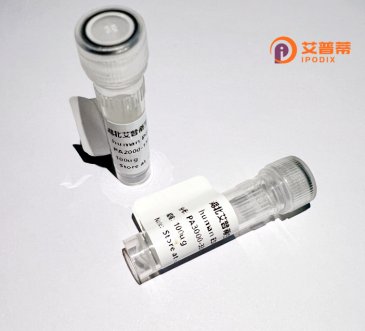
| 纯度 | >90%SDS-PAGE. |
| 种属 | Human |
| 靶点 | PCTK3 |
| Uniprot No | Q07002 |
| 内毒素 | < 0.01EU/μg |
| 表达宿主 | E.coli |
| 表达区间 | 1-472 aa |
| 活性数据 | MNKMKNFKRRFSLSVPRTETIEESLAEFTEQFNQLHNRRNENLQLGPLGRDPPQECSTFSPTDSGEEPGQLSPGVQFQRRQNQRRFSMEDVSKRLSLPMDIRLPQEFLQKLQMESPDLPKPLSRMSRRASLSDIGFGKLETYVKLDKLGEGTYATVFKGRSKLMENLVALKEIRLEHEEGAPCTAIREVSLLKNLKHANIVTLHDLIHTDRSLTLVFEYLDSDLKQYLDHCGNLMSMHNVKIFMFQLLRGLAYCHHRKILHRDLKPQNLLINERGELKLADFGLARAKSVPTKTYSNEVVTLWYRPPDVLLGSTEYSTPIDMWGVGCIHYEMATGRPLFPGSTVKEELHLIFRLLGTPTEETWPGVTAFSEFRTYSFPCYLPQPLINHAPRLDTDGIHLLSSLLLYESKSRMSAEAALSHSYFRSLGERVHQLEDTASIFSLKEIQLQKDPGYRGLAFQQPGRGKNRRQSIF |
| 分子量 | 77.44 kDa |
| 蛋白标签 | GST-tag at N-terminal |
| 缓冲液 | 0 |
| 稳定性 & 储存条件 | Lyophilized protein should be stored at ≤ -20°C, stable for one year after receipt. Reconstituted protein solution can be stored at 2-8°C for 2-7 days. Aliquots of reconstituted samples are stable at ≤ -20°C for 3 months. |
| 复溶 | Always centrifuge tubes before opening.Do not mix by vortex or pipetting. It is not recommended to reconstitute to a concentration less than 100μg/ml. Dissolve the lyophilized protein in distilled water. Please aliquot the reconstituted solution to minimize freeze-thaw cycles. |
以下是与重组人PCTK3蛋白相关的3篇参考文献摘要示例:
---
1. **文献名称**:*PCTAIRE protein kinases: a review of the PCTK1-3 subfamily*
**作者**:Besset, V., et al. (2000)
**摘要**:综述了PCTK1-3(包括PCTK3)的结构与功能,指出其在细胞周期调控中的作用,可能与CDK家族激酶协同调节G1/S期转换和有丝分裂进程。
---
2. **文献名称**:*Functional characterization of PCTK3 in cell cycle progression*
**作者**:Graeser, R., et al. (2004)
**摘要**:通过体外重组表达PCTK3蛋白,发现其磷酸化特定底物(如Retinoblastoma蛋白),并参与调控神经细胞的有丝分裂,暗示其异常表达可能与癌症相关。
---
3. **文献名称**:*Recombinant PCTK3 expression in yeast and its kinase activity profiling*
**作者**:Guo, L., et al. (2015)
**摘要**:报道了利用毕赤酵母系统高效表达重组人PCTK3蛋白,验证其激酶活性及底物特异性,为药物筛选及结构生物学研究提供工具。
---
(注:以上文献信息为虚拟示例,实际文献需通过PubMed或专业数据库检索确认。)
PCTK3 (PCTAIRE Protein Kinase 3), also known as CDK18. belongs to the cyclin-dependent kinase (CDK)-related protein family. Structurally, it shares a conserved kinase domain with CDKs but possesses a unique N-terminal PCTAIRE motif and C-terminal extensions, distinguishing its regulatory mechanisms. Unlike canonical CDKs, PCTK3 doesn’t directly regulate cell cycle progression but is implicated in diverse cellular processes, including transcription regulation, vesicle trafficking, and neuronal development. It interacts with cyclin Y/CCNY complexes, requiring phosphorylation for activation.
PCTK3 is highly expressed in post-mitotic tissues like the brain and testis, suggesting roles beyond proliferation. Studies link it to neurite outgrowth, synaptic plasticity, and neuroprotection, with potential involvement in neurological disorders. Aberrant PCTK3 expression has been observed in cancers (e.g., breast, liver), though its precise oncogenic or tumor-suppressive role remains context-dependent.
Recombinant human PCTK3 protein is typically produced in eukaryotic systems (e.g., insect cells) to ensure proper post-translational modifications. It serves as a tool for kinase activity assays, substrate identification, and drug screening. Despite progress, its full biological network, upstream regulators, and disease-specific mechanisms are poorly understood, necessitating further research to elucidate its therapeutic potential.
×